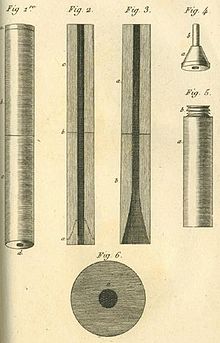Laennec wrote the classic treatise De l'Auscultation Médiate, published in August 1819. The preface reads:
In 1816, I was consulted by a young woman laboring under general symptoms of diseased heart, and in whose case percussion and the application of the hand were of little avail on account of the great degree of fatness. The other method just mentioned [direct auscultation] being rendered inadmissible by the age and sex of the patient, I happened to recollect a simple and well-known fact in acoustics, . . . the great distinctness with which we hear the scratch of a pin at one end of a piece of wood on applying our ear to the other. Immediately, on this suggestion, I rolled a quire of paper into a kind of cylinder and applied one end of it to the region of the heart and the other to my ear, and was not a little surprised and pleased to find that I could thereby perceive the action of the heart in a manner much more clear and distinct than I had ever been able to do by the immediate application of my ear.
Laennec had discovered that the new stethoscope was superior to the normally used method of placing the ear over the chest, particularly if the patient was overweight. A stethoscope also avoided the embarrassment of placing the ear against the chest of a woman.
Laennec is said to have seen schoolchildren playing with long, hollow sticks in the days leading up to his innovation.[4] The children held their ear to one end of the stick while the opposite end was scratched with a pin, the stick transmitted and amplified the scratch. His skill as a flautist may also have inspired him. He built his first instrument as a 25 cm by 2.5 cm hollow wooden cylinder, which he later refined to comprise three detachable parts.
His clinical work allowed him to follow chest patients from bedside to the autopsy table. He was therefore able to correlate sounds captured by his new instruments with specific pathological changes in the chest, in effect pioneering a new non-invasive diagnostic tool. Laennec was the first to classify and discuss the termsrales, rhonchi, crepitance, and egophony – terms that doctors now use on a daily basis during physical exams and diagnoses. In February 1818, he presented his findings in a talk at the Academie de Medecin, later publishing his findings in 1819.
Laennec coined the phrase mediate auscultation, (indirect listening) as opposed to the popular practice at the time of directly placing the ear on the chest (immediate auscultation). He named his instrument thestethoscope, from stethos (chest), and skopos (examination).
Not all doctors readily embraced the new stethoscope. Although the New England Journal of Medicine reported the invention of the stethoscope two years later, in 1821, as late as 1885 a professor of medicine stated, "He that hath ears to hear, let him use his ears and not a stethoscope." Even the founder of the American Heart Association, L. A. Connor 1866–1950) carried a silk handkerchief with him to place on the wall of the chest for ear auscultation.[5]
Laennec often referred to the stethoscope as "the cylinder," and as he neared death only a few years later, he bequeathed his own stethoscope to his nephew, referring to it as "the greatest legacy of my life."
The modern binaural stethoscope with two ear pieces was invented in 1851 by Arthur Leared. George Cammann perfected the design of the instrument for commercial production in 1852, which has become the standard ever since.



No comments:
Post a Comment